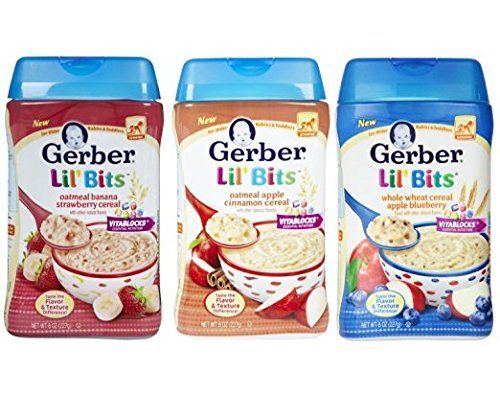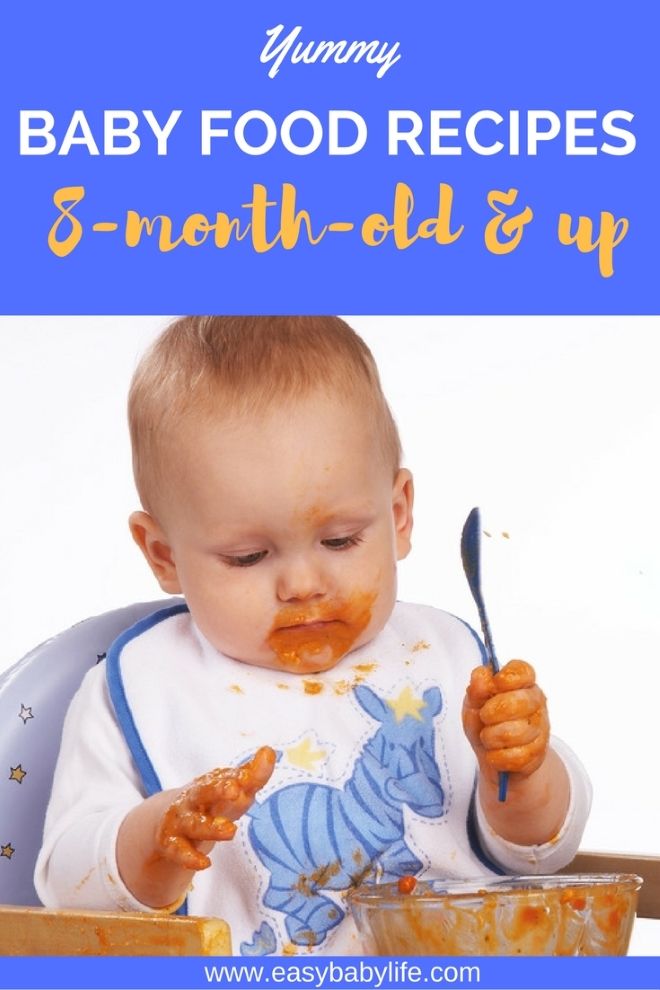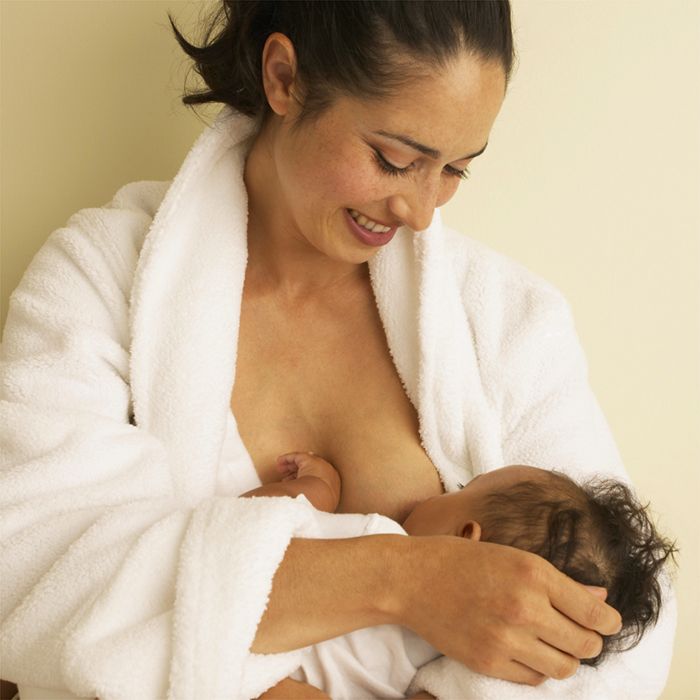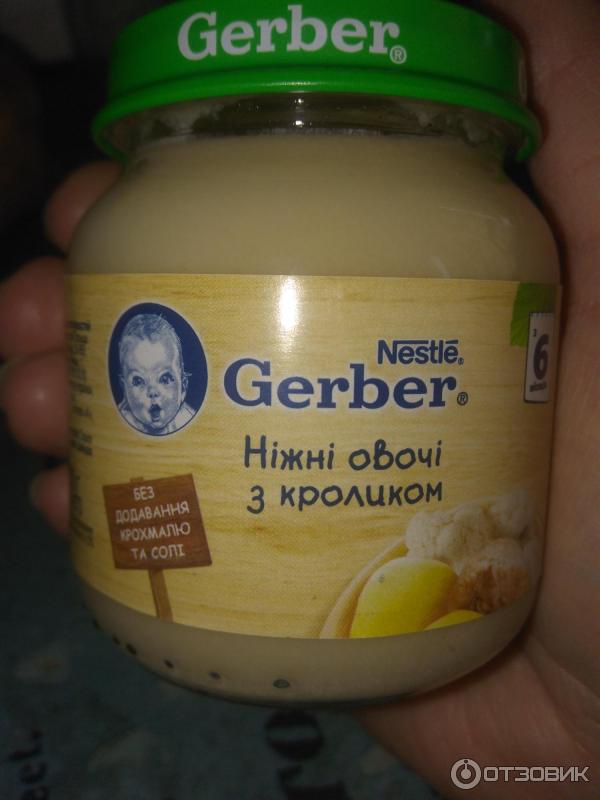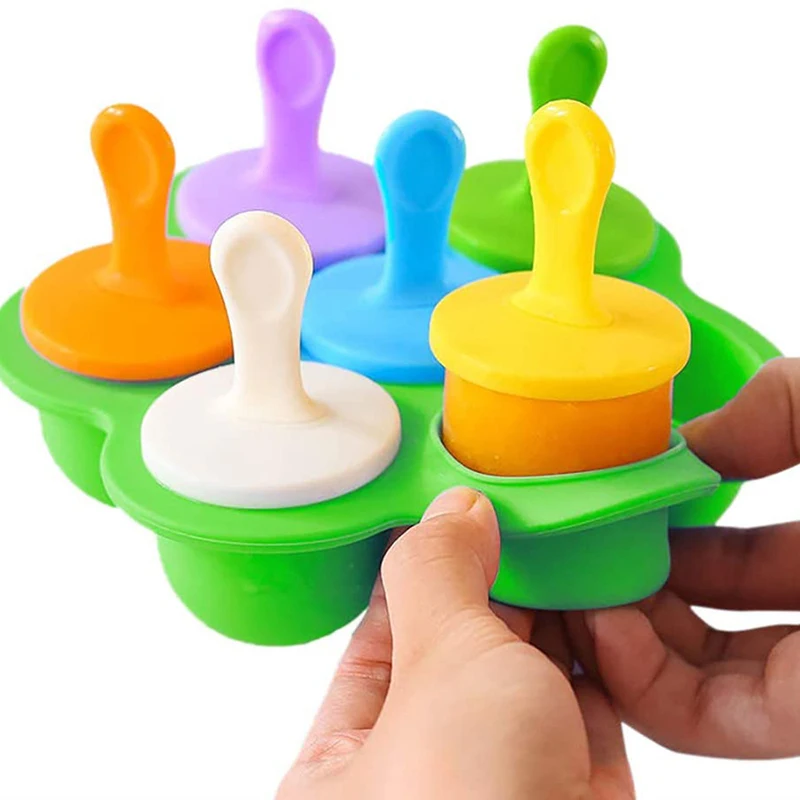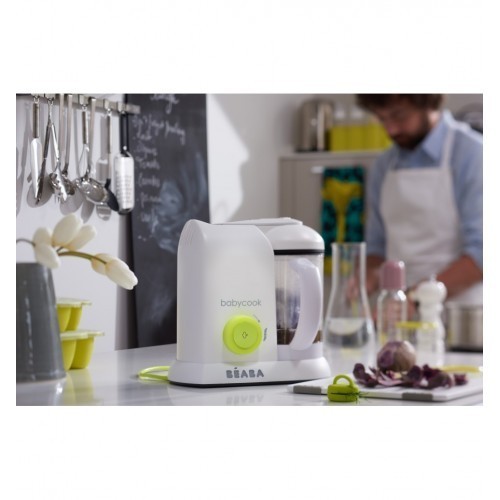Baby food oatmeal cereal
Oatmeal for Babies (Stage One Baby Food)
Ditch the box! And try this easy Oatmeal for Babies recipe instead. Made with simple nutrient-dense ingredients in less than 10 minutes, it’s perfect for your baby’s first bite or added into their favorite fruit or veggie puree. I’ll also show you how to serve oatmeal as a finger food for baby-led weaning. There is nothing this baby oatmeal won’t do, and it tastes so much better than the store-bought boxed version! Baby food for 6+ months – stage 1 baby food!
Medically reviewed by Jamie Johnson, Registered Dietitian Nutritionist (RDN), and Lauren Braaten, Pediatric Occupational Therapist (OT).
Oatmeal for BabiesA smooth and creamy oat cereal for your baby doesn’t have to come from a box!
This easy oatmeal baby cereal is loaded with omega-3 fatty acids, antioxidants, fiber, protein, calcium and manganese and takes only 10 minutes to make!
That’s right! In 10 minutes you can have a stash of freezer-friendly oatmeal for your baby.
Yes, it can be that easy!
First time making homemade baby food? Then, I would suggest that you start by reading my very in-depth Guide on how to Make Homemade Baby Food – which goes over all the important information such as the best cooking tools to have on hand, safe storage, how to know when baby is ready for solids, how to introduce purees, the best first foods for baby, and more! You can also check out my best-selling cookbook for even more information and recipes!
Oatmeal for Babies Video
Watch this video to see how easy this Oatmeal Cereal recipe for your baby actually is to make!
Reasons to Love this Baby Oatmeal- baby food for 4-6 months and up
- stage 1 baby food
- can also be served for baby-led weaning
- 1 main ingredient, plus 2 easy add-ins
- budget-friendly – less than 2 cents per ounce
- easy to make – less than 10 minutes
- can serve alone or with baby’s favorite puree
- creamy and smooth
- homemade
- freezer-friendly
- healthy – full of essential nutrients for a growing baby
- easy to flavor – 6 great combos below
Make sure to read the recipe card below for the full ingredient list and instructions!
- Oats: are a great source of two different types of fiber, which help keep your little ones’ digestive tract going strong.
 Oats are also packed with antioxidants, manganese, phosphorus, copper, iron, zinc, and vitamin B1. They also help stabilize blood sugar as well as support baby’s cardiovascular health.
Oats are also packed with antioxidants, manganese, phosphorus, copper, iron, zinc, and vitamin B1. They also help stabilize blood sugar as well as support baby’s cardiovascular health. - Chia Seeds: are high in antioxidants, omega 3-fatty acids, fiber, and magnesium and are a good source of protein and calcium. They are great for digestive health, building healthy and strong bones as well as overall heart health. We are going to add in a big pinch to this recipe, but you can leave them out if you prefer.
- Hemp Seeds: are a good source of protein and fiber and are also high in GLAs, manganese and vitamin E. Hemp seeds are great for aiding digestive health and promoting a healthy heart. You can leave these out if you prefer or add in ground flax seeds instead.
This homemade oatmeal cereal is loaded with essential vitamins and minerals for a growing baby.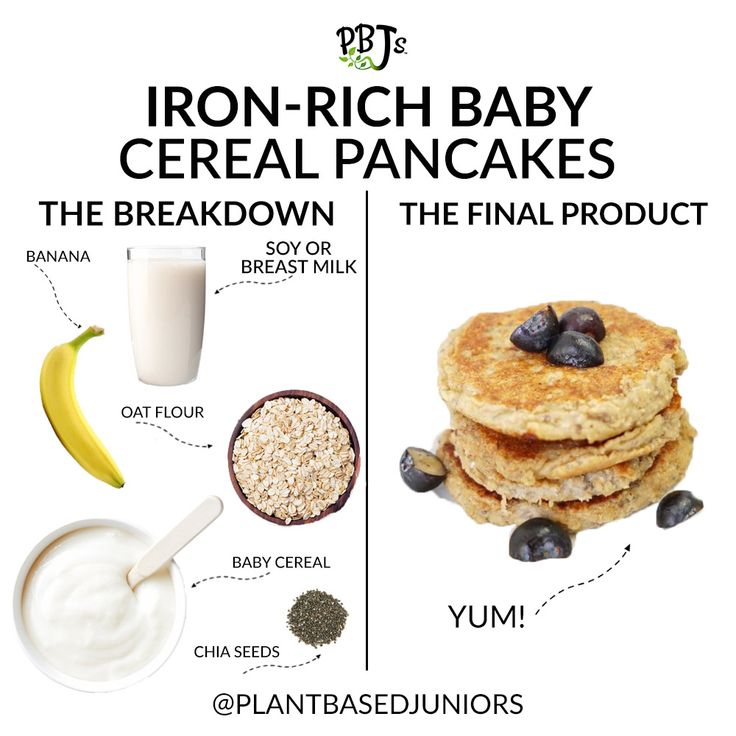
- packed with two different types of fiber
- great source of omega-3 fatty acids which are essential for brain, eyes and organ development
- has antioxidants that are essential for eliminating the hazards of free-radicals
The only difference between the 3 main types of oats – steel-cut, rolled and instant, is how much the oat grout is processed. The result of this process is different textures of oats with varying cooking times.
- Steel-Cut Oats: are the least processed of the oats, and they retain about the same amount of fiber as rolled or instant. Steel-cut oats are a great option if you are going to blend your oats into a smooth puree for baby. Since it is thicker and chewier oat, it is best to serve to babies 11 months and older if not blending.
- Rolled or Old-Fashioned Oats: Also known as old-fashioned or whole oats, rolled oats are flat, pre-cooked and dried.
 While they have a similar amount of fiber as steel-cut oats, they are more versatile and take less time to cook. Rolled oats are extremely easy to blend into a smooth puree, served cold as a finger food, and they can easily be served to toddlers.
While they have a similar amount of fiber as steel-cut oats, they are more versatile and take less time to cook. Rolled oats are extremely easy to blend into a smooth puree, served cold as a finger food, and they can easily be served to toddlers. - Instant Oats: are the more processed of the three oats and cook very quickly. While you can certainly use instant oats to make a baby cereal, since they tend to be slightly lower in fiber, I recommend the other two oat varieties first.
Gluten-Free Oats: all oats are naturally gluten-free, but they may be processed on machinery that also processes wheat. If you are looking to introduce baby to gluten-free oats, then make sure you look for a brand that is labeled as Gluten-Free. This is my favorite brand of Gluten-Free Oats.
How to Make Baby OatmealThere are several different ways to cook oats depending on which type of oat you are using.
Old-Fashioned Oats- Boil: bring 2 cups of water to a boil.

- Add Oats: add in 1 cup of old-fashioned oats along with a pinch of chia seeds, hemp seeds and any spices you are using.
- Cook: turn down the heat to medium-low and cook the oats for 5 minutes or until all of the water is gone and the oats are soft. Let cool slightly.
- Blend: transfer the oats to a blender or food processor and puree for 1-2 minutes, adding water in 1/4 cup increments if needed, until completely smooth.
- Eat: serve to baby or freeze for later.
- Boil: bring 3 cups of water to a boil.
- Add Oats: add in 1 cup of steel-cut oats along with a pinch of chia seeds, hemp seeds and any spices you are using.
- Cook: turn down the heat to medium-low and cook for 25-30 minutes or until all of the water is gone and the oats are soft. Let cool slightly.

- Blend: transfer the oats to a blender or food processor and puree for 1-2 minutes, adding water in 1/4 cup increments if needed, until completely smooth.
- Eat: serve to baby or freeze for later.
- Boil: bring 1 cup of water to a boil.
- Add Oats: add in 1/2 cup of instant oats along with a pinch of chia seeds, hemp seeds and any spices you are using to a boil.
- Cook: turn down the heat to medium-low and cook the oats for 1-2 minutes or until all of the water is gone and the oats are soft. Let cool slightly.
- Blend: transfer the oats to a blender or food processor and puree for 1-2 minutes, adding water in 1/4 cup increments if needed, until completely smooth.
- Eat: serve to baby or freeze for later.
I have found that cooking the oats first and then blending them, creates the smoothest oatmeal for your baby.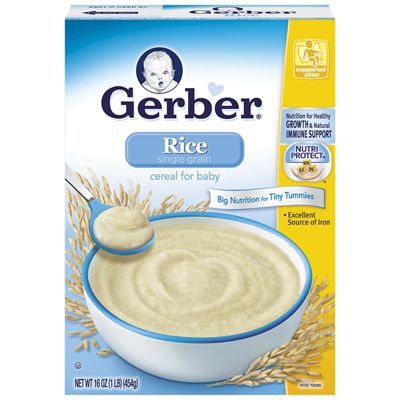 But there are a couple of other ways to make oatmeal for your baby.
But there are a couple of other ways to make oatmeal for your baby.
Love the idea of fresh oatmeal for your baby, but are short on time? Then let me introduce to you the BEABA Babycook.. aka your new best friend! With a touch of a button, the Babycook will cook the oats and puree them into whatever consistency you prefer. It’s definitely kitchen magic!
Place 1 cup of old-fashioned oats and 1 cup of water inside of the grain insert basket, and place the basket into the glass container, closing the lid. Fill the reservoir tank to a level 3, close and lock the lid. Press the steam button, and let the Babycook do all the work! Once steamed, transfer the cooked oats to the glass container, leaving the water that is already in there and adding in an additional 1/4 cup of fresh breast milk, formula or water. Close the lid, and hit the blend button for 1 minute or until the puree is smooth. You may need to add more liquid to the puree if needed in 2 tablespoon increments.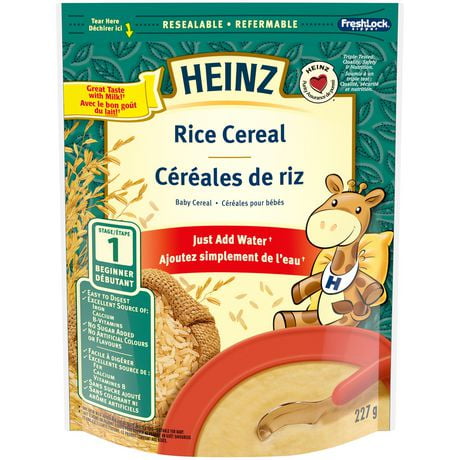
Full Review: read my full, in-depth and honest review of the BEABA Babycook Neo here, including a list of pros and cons! Make sure to grab 15% off your Babycook with code (BabyFoode15)!
Oat Powder- Grind Oats: Place 1 cup of old-fashioned oats in a coffee grinder or blender. Grind for 1-2 minutes or until you have a very fine oat powder.
- Add Hot Water: In a microwave-safe bowl, add in roughly 1 tablespoon oat powder and 1-2 tablespoons hot or boiling water. Stir until smooth adding more water if needed. Let sit until warm enough to eat.
- Blender or Food Processor
- Storage Containers for Fridge
- Freezer Tray
- Stasher Bag
- highchair
- suction bowl or baby bowl
- baby spoon
- bib with catch pocket
- BEABA Babycook
Frequently Asked Questions
When can baby eat oatmeal?
Baby can have oats as one of their first foods. When a baby can start on solids is determined by their own rate of development, which generally comes between 4-6 months of age. Some of the developmental milestones babies need to reach in order to start solids include: if your baby has solid control of their head and neck, if your baby has doubled in weight, and if your baby is reaching for or opening their mouth when you eat (see my guide here). Before you start your baby on purees, you should consult with your pediatrician to make sure your child is developmentally ready.
When a baby can start on solids is determined by their own rate of development, which generally comes between 4-6 months of age. Some of the developmental milestones babies need to reach in order to start solids include: if your baby has solid control of their head and neck, if your baby has doubled in weight, and if your baby is reaching for or opening their mouth when you eat (see my guide here). Before you start your baby on purees, you should consult with your pediatrician to make sure your child is developmentally ready.
Can oatmeal be baby’s first food?
Oatmeal can 100% be your baby’s first food if you want it to be. It is recommended to wait to introduce the top eight allergen foods to your baby once a few other well-tolerated foods have been introduced, but otherwise, foods can be introduced in any order so choose whatever you are most excited for your baby to have.
Is oatmeal a common allergen for baby?
No, oatmeal is not a common allergen, however, as with any food, start with a small portion and be aware of any signs that might be an allergic reaction after introducing it.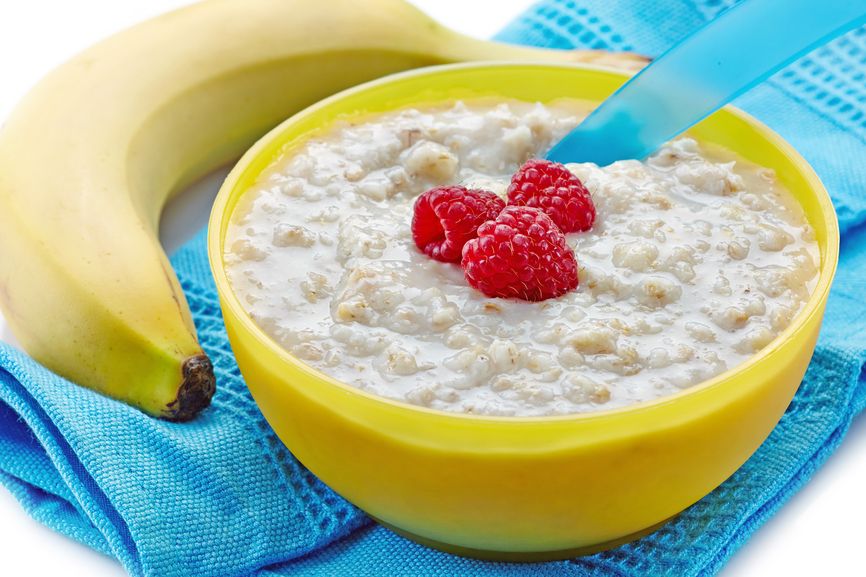
Do oats cause constipation for babies?
No, oatmeal can actually help relieve constipation in babies due to the high fiber content that makes it easier on your baby to pass stools.
Can you add spices/herbs to this recipe?
n this recipe, we are adding in a pinch of chia seeds and hemp seeds, but feel free to add in a pinch of spices if you want. Some great options are: cinnamon, nutmeg, pumpkin spice blend, allspice, cloves or fresh ginger.
Tip on Spices: I usually add in spices to my baby food purees, but you can add or leave out spices in all of your baby food. You do you! Either way, this puree will taste amazing.
Feeding Tips for Purees
- Throwing spoons – is a common phase that all babies go through at one point or another. One of the best ways to handle spoon throwing is to ignore it and keep feeding baby as usual (with an extra spoon you already have at the table).
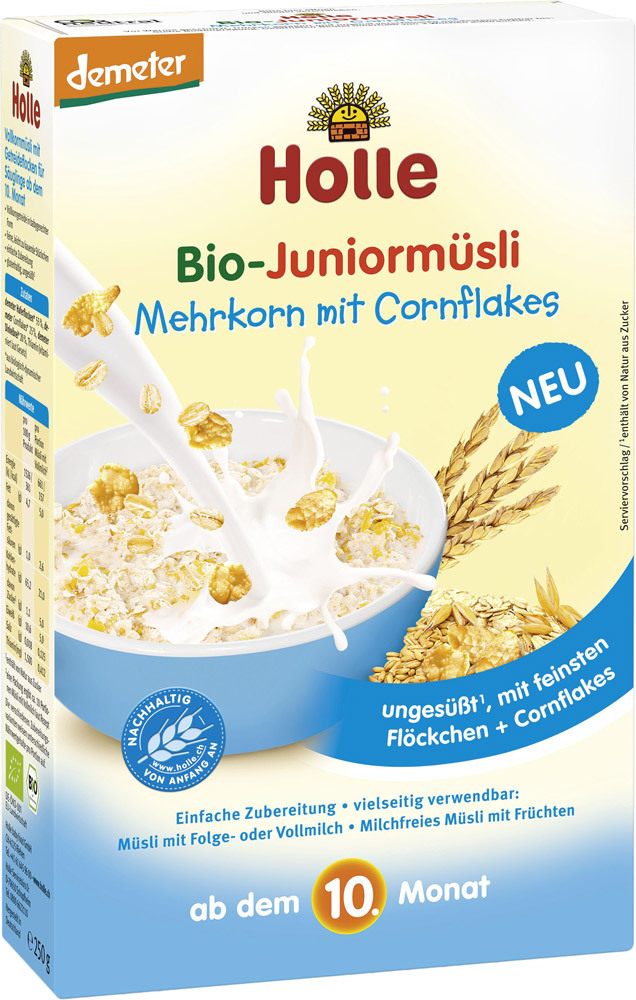 If baby ends up also throwing back up spoons #2 AND #3, simply encourage your baby to eat with their hands until they appear to be finished with the meal. Give baby plenty of opportunities to practice putting items in and taking items out of containers outside of meal times.
If baby ends up also throwing back up spoons #2 AND #3, simply encourage your baby to eat with their hands until they appear to be finished with the meal. Give baby plenty of opportunities to practice putting items in and taking items out of containers outside of meal times. - Follow your baby’s lead – when feeding purees from a spoon, sometimes there’s a tendency to keep offering bites past the point of your baby being full. Always follow baby’s cues for when they are done eating. Turning away from the spoon, closing her mouth, or pushing food away are all signs that baby is finished with the meal.
- Purees are great to keep in your baby’s regular rotation of foods – but if you start feeding with traditional weaning using purees, make sure to progress beyond eating ONLY purees. Once baby can safely and comfortably swallow purees (usually by 7 or 8 months) it’s time to introduce other textures, such as teething biscuits and soft cooked finger foods.
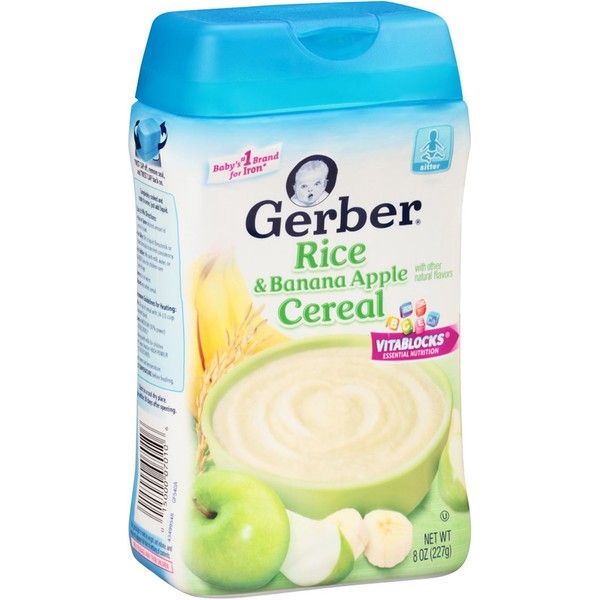 Moving onto additional textures in a timely manner may help prevent feeding difficulties at a later age.
Moving onto additional textures in a timely manner may help prevent feeding difficulties at a later age.
You can store the oatmeal cereal in an airtight container in the fridge for 3 days.
FREEZERThis oatmeal puree can be frozen for up to 3 months.
- Spoon pureed oatmeal into a freezer storage container (this is my favorite freezer storage container) – do not overfill.
- Place the lid on the storage container or cover with a piece of saran wrap and label with date and recipe name.
- Place the tray into the freezer and let freeze completely – preferably overnight.
- Pop-out the baby food cubes and place in a zip-lock baggie or stasher bag – don’t forget to re-label the baggie or stager bag for future reference.
Label Tip: Don’t forget to label your purees before you place them in the fridge or freezer with the name of the puree and date you made it. Take it from me, you will completely forget when and what is in your freezer by the end of the week;).
Take it from me, you will completely forget when and what is in your freezer by the end of the week;).
While Oatmeal is great by itself, it’s also super easy to mix and match with other nutrient-dense baby food purees. Give these fun flavor combos a try! Stage 2 Baby Food.
- Apples
- Carrots
- Pears
- Sweet Potatoes
- Green Beans
- Peas
- Pumpkin
- Mango
- Yogurt
Oats can be hard food for your baby to pick up and feed themselves (oh the mess!). A great way to serve oats as a finger food is by simply spooning a couple of strips or round shapes of cooked oats on a plate and then letting them cool off on the counter or in the fridge. Once cold, the oats will harden enough for your baby to be able to pick them up by themselves. I’m not saying there won’t be a mess.. but it will be less of a mess and definitely easier for your baby to self-feed. Babies are usually ready for baby-led weaning around 6+ months of age.
Babies are usually ready for baby-led weaning around 6+ months of age.
Once you get the basics of oatmeal down for your baby, you can have some fun and serve them some flavorful combinations. Here are some great options that baby, toddler, kids and even you will love!
- Apples + Cinnamon: add in a couple of heaping spoonfuls of grated apple and a big pinch of cinnamon to oats right before serving. Can add a touch of maple syrup or brown sugar into toddlers or kid’s bowls.
- Spinach + Pineapple: cook the oats with a handful of frozen pineapple. Add to a blender along with a handful of spinach, pulse or puree until spinach is incorporated.
- Blueberries, Cinnamon and Vanilla: add in a handful of frozen blueberries, a pinch of cinnamon and a drizzle of vanilla extract while cooking the oats. Serve whole or blend for baby.
- Banana + Peanut Butter: add in slices of a very ripe (lots of brown spots) banana to the oats while they are cooking.
 Mash the banana while it is cooking into small pieces. Spoon oats with banana into a bowl and add a swirl of peanut butter (or any nut or seed butter you prefer) right before serving. Serve whole or blend for baby.
Mash the banana while it is cooking into small pieces. Spoon oats with banana into a bowl and add a swirl of peanut butter (or any nut or seed butter you prefer) right before serving. Serve whole or blend for baby. - Carrots + Flax: add in a handful of grated carrots to the oats while they are cooking. Serve whole or blend for baby. Spoon the oats and carrots into a bowl and top with a sprinkle of ground flax seeds. You can also add finely chopped walnuts and raisins to toddlers and kid’s bowls.
- Mango with Coconut Milk: cook the oats in canned coconut milk (instead of the water) and then add in a handful of fresh or frozen cubed mango. While cooking, mash the mango with the back of a spoon. Serve whole or blend for baby.
Or watch a shortened version of this video here.
- 2 cups water
- 1 cup old fashioned oats
- 1/2 tsp hemp seeds (optional)
- 1 /2 tsp chia seeds (optional)
Boil: In a medium saucepan, bring 2 cups of water to a boil.
Add Oats: add in 1 cup of old-fashioned oats along with the chia seeds, hemp seeds and any spices you are using.
Cook: turn down the heat to medium-low and cook the oats for 5 minutes, stirring occasionally, or until all of the water is gone and the oats are soft. Let cool slightly.
Blend: transfer the oats to a blender or food processor and puree for 1-2 minutes, adding water in 1/4 cup increments if needed, until completely smooth. I had to add 1/2 cup of water to my oatmeal. You will want the oat cereal to be on the thinner side so it doesn't become sticky. The oats will continue to absorb liquid as they cool, so add more water, breast milk or formula as needed.

Eat: serve to baby or freeze for later.
Age: 4+ months
Yield: Makes roughly 20 ounces
Type of Oats: This recipe is for old-fashioned oats. For steel-cut or instant oats, read the full post.
Adding Spices: you can add a big pinch of cinnamon or pumpkin pie spice mix, or a smaller pinch of nutmeg or cloves to these oats before blending.
Chia and Hemp Seeds: are added for a nutritional boost, but you can add or omit if you prefer. You can get both of these at any health food store or online here (chia / hemp).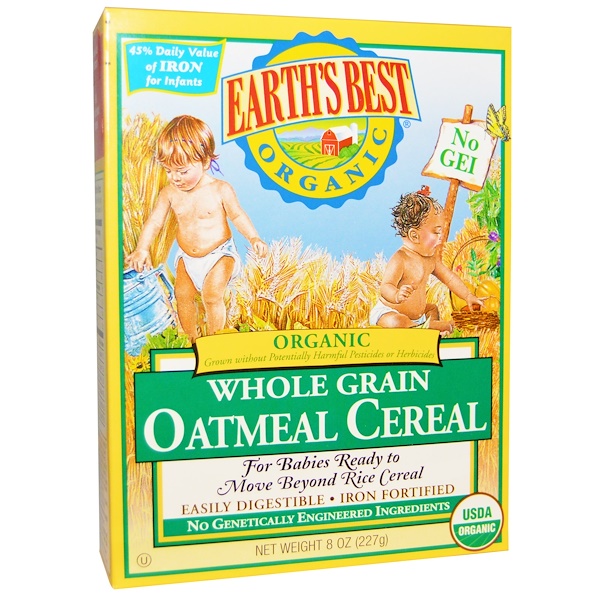
Storage: Fridge – store in an airtight container in the fridge for 3 days or in the freezer for up to 3 months.
Thawing: Once thawed the oats can become pretty thick. To thin the oatmeal out again, just add water, breast milk, formula or another fruit or veggie to the oatmeal 1 tablespoon at a time until you reach your desired consistency.
Blender
Freezer Tray
Grabease Utensil
Bumkins Baby Bowl
Tripp Trapp High Chair
Did you make this recipe?
Tag @babyfoode on Instagram and hashtag it #babyfoode!
Pin Recipe Email a Friend
Homemade Oatmeal Cereal for Babies
Making Homemade Oatmeal Cereal is one of the most rewarding and easiest ways to feed your new baby. And after doing it, you’ll wonder why you ever bothered buying it at the store.
When my son, Kenya, was a baby the first solid my pediatrician told me to feed him was rice cereal. Rice cereal is a natural first food choice for babies and is incredibly simple for parents to prepare. My husband and I were so excited for our son’s first day eating solid food to arrive that we set aside an entire Saturday morning to document every last second, from his first bite to the inevitable mess that would follow. I’m so glad the footage exists, though the images of that day are indelibly printed in my brain. His expressions tasting, moving the food around in his mouth, and finally swallowing were absolutely priceless.
Rice cereal became his daily meal and I researched to find the best brand to serve him. One day after opening a new box, I realized it was barely half full, just like every box I’d opened before. I thought to myself, why am I spending $4 for a box of rice cereal when I can easily make it homemade for pennies per serving? And so I did. Not only was it easy it do and much more affordable, it was my son’s first exposure to me cooking for him.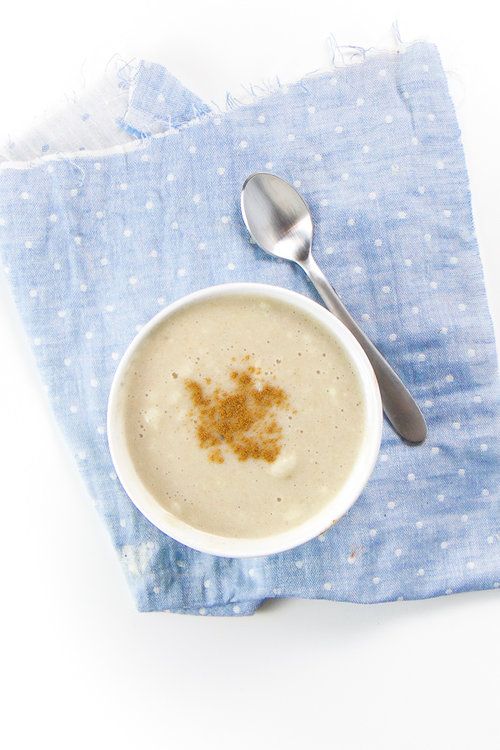
As Kenya progressed to eating a wider variety of foods, I started adding oatmeal cereal to his repertoire as well. It’s amazing to me how much more fresh homemade cereals taste compared to what is sold in stores for new eaters (not to mention how much less expensive they are). All you need to do is puree old fashioned oats in a blender or food processor and add water. It’s that simple.
So the next time you’re at the grocery and reach for that container of overpriced oatmeal cereal, remember that you probably already have the one ingredient you need to make it for your baby right in your pantry!
Save Recipe Print Recipe
Servings: 1
Author: Catherine McCord
Prep Time 1 minute
Cook Time 5 minutes
- ▢ 1/2 cup old fashioned oats (aka 5 minute oats)
Place oats in a food processor, pulse for 15 to 30 seconds or until finely ground.
Store the oat powder in a sealed container in the refrigerator or freezer or in a cool dark place for up to 3 months.

To make 1 serving for a 5-9 month old baby
Bring 1/2 cup of water to a boil and sprinkle in 2 tbsp of the ground oats and ½ teaspoon ground cinnamon, if desired.
Whisk continuously for 30 seconds and then occasionally for 3-5 minutes or until the mixture is thick and creamy.*
Did you make this recipe?Mention @Weelicious or tag #weelicious!
Published August 4, 2022 by Catherine McCord
Categorized in All Recipes, First Foods, Purees, Recipes 10-12 Months, Recipes 6-9 Months
About the Author
Catherine is a mama of three. A Kentucky girl living in California. Here’s what I know: all kids can be great eaters and mealtime must be easy.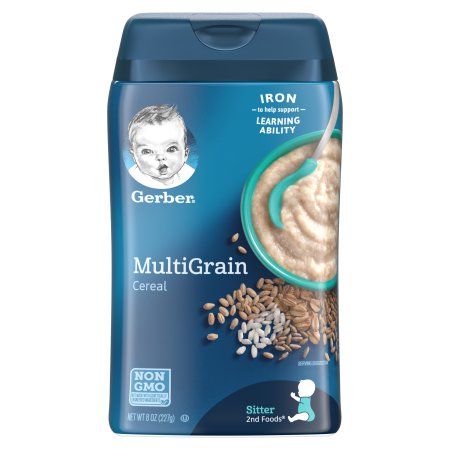 I create simple, healthy recipes the whole family will love.
I create simple, healthy recipes the whole family will love.
Oatmeal for children - Encyclopedia Baby food
Viktoriya Levchuk©Oatmeal can be loved or not loved, but all children know how good it is for the body. Oatmeal is a great food for babies who continue to get introduced to solid foods. Grains are rich in essential nutrients such as fiber, protein and vitamins. No doubt, oatmeal is healthy for children, but what age is suitable for complementary foods? Also, is it possible to be allergic to oats? We will answer these questions and talk about the benefits of oatmeal.
Benefits of oats for children
Table of contents:
Oats—commonly known as oatmeal or instant porridge—are one of the most nutritious grains you can buy.
Unlike many other grains that undergo extensive and destructive processing before reaching the store shelves, oats are always whole. This is regardless of whether it is cut, rolled, fast or instant.
This means that it retains all the minerals and vitamins found in the germ, endosperm and bran. .. and that's a lot of good!
.. and that's a lot of good!
Oats are an excellent source of soluble fiber, protein and B vitamins, thiamine, riboflavin and B6. It also provides iron, calcium, magnesium, selenium and phosphorus.
Children should enjoy oats from a very young age, as they also play a very important role in maintaining health throughout adulthood.
When eating oatmeal, it is important to know its benefits for baby food:
- Gluten-free oatmeal. Children who are allergic to gluten cannot consume grains such as wheat, rye and barley for a balanced diet. But they can eat oats, which are gluten-free and contain the same vitamins and minerals. Oatmeal helps improve the nutritional value of a gluten-free diet, which can lead to nutritional deficiencies in children.
- Oats are good for constipation. Since oats are rich in fiber, they help fight constipation. Doctors recommend making oats part of the diet when frequent constipation occurs, and this suggestion even works for babies.
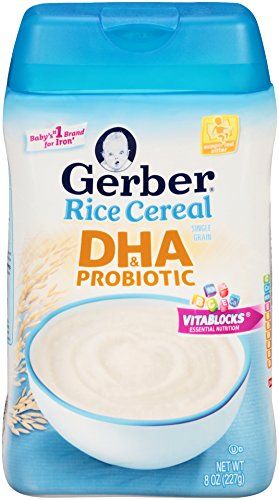
- Oatmeal for children perfectly strengthens the immune system. Oats contain a type of sugar called beta-glucan, which boosts the production of immune system cells. Thus, regular consumption of oats can keep the immune system healthy, which is an advantage for a growing child.
- Oatmeal helps reduce inflammation. Oats contain compounds called avenanthramides, which can reduce inflammation from several causes, including infections and wounds. Babies with certain autoimmune conditions can benefit from the anti-inflammatory properties of oats.
- Oatmeal improves insulin sensitivity. Babies born with congenital type 1 diabetes may benefit from eating oats as the grain reduces insulin resistance. This means that the body makes better use of the injected insulin, reducing the effects of diabetes.
- Essential food for children with GERD. One treatment option for children with gastroesophageal reflux disease (GERD) is to give them solid foods in the form of thicker purees.
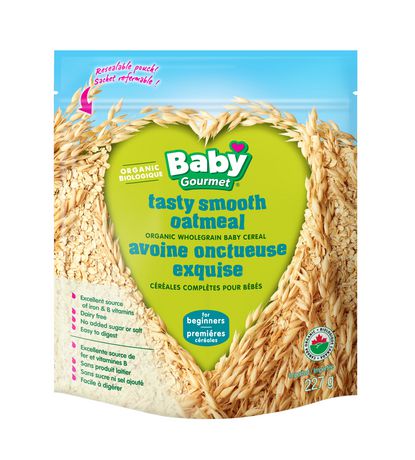 Oatmeal is considered a safe and healthy thickener for these children.
Oatmeal is considered a safe and healthy thickener for these children.
Benefits of oatmeal in baby food
Oats and gluten
Before 6 months of age, children should not be given foods containing gluten, as this is thought to increase their risk of developing celiac disease. Whether oats are considered a gluten-containing grain is the subject of some speculation.
Gluten is a protein found in wheat, rye, barley and triticale (a hybrid of rye and wheat). Oats do not belong to any of these groups; thus, people with gluten intolerance usually don't have to worry about gluten in uncontaminated oats. However, there are several concerns about oat consumption.
Oats contain avenin, a protein similar to gluten. In some people with celiac disease, avenin activates the same immune cells that respond to gluten. However, most people with the disease can tolerate gluten-free oats without problems.
A 2014 study found that eating 100 grams (g) of oats a day for 3 days activated immune cells affecting avenin, but only in 8 percent of participants.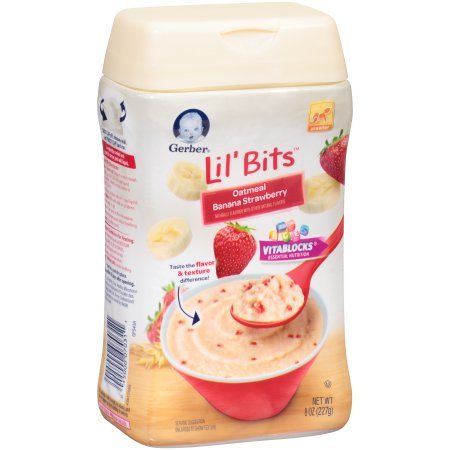 The authors of the study concluded that a smaller amount of oats is probably good for people with celiac disease.
The authors of the study concluded that a smaller amount of oats is probably good for people with celiac disease.
The Celiac Disease Society recommends monitoring anti-tTG antibody levels before and after adding oats to the diet. This provides clear data on how eating oats affects a person.
People who try oats should start with small amounts and record any symptoms they experience. If symptoms do not appear, and the level of antibodies in the blood remains stable, you should continue to eat oats.
There is also the problem of cross-contamination, where oats can be contaminated with other gluten-containing grains with which they are grown, harvested, processed or stored. People on a gluten-free diet can only eat uncontaminated oats. A very small number of people with celiac disease may still be sensitive to gluten, an uncontaminated oat product.
It is up to the individual to decide whether or not to include gluten-free oats in their diet - some people choose not to try it. However, they understand important benefits:
However, they understand important benefits:
- oats add variety to a gluten-free diet
- oats are a good source of soluble fiber, which can support gut health and help treat high cholesterol and keep blood sugar levels stable.
Indeed, pure oat products are marketed as an acceptable part of a gluten-free diet in some parts of the world, especially in Scandinavian countries. However, it is still advisable to consult a doctor if you plan to administer oats to a child with a family history of gluten intolerance.
Oats
Oatmeal is a processed oat. This is what we buy in the market. But oatmeal comes in several varieties.
1. Oat flakes
When we think about oats, a picture of oat flakes comes to mind. Oatmeal is oatmeal made from whole grain oats. They are made by steaming oat grains (without the rind) and then passing them through a roller before drying. Rolled oats come in two varieties: slow-cooked and fast-cooked oats.
2. Coarse oatmeal
Whole oatmeal, not refined oatmeal, is pounded into a coarse meal filled with fiber. Baby oatmeal mix may contain oatmeal, as it mixes well with hot water.
3. Instant Oats
This is the most processed type of oats. Oat grain is boiled, rolled and then dried before being packaged. Rolled oats are semi-finished and are usually found in ready-to-eat baby cereals that can be made by simply adding hot or boiling water.
4. Whole grain oats
If oat flakes are processed, then oat grains are hardly touched. Whole grain oats, also called whole grain oats, are raw oats in their purest form with 100% of their nutritional value retained.
5. Cut oats
Whole oats that are cut into small pieces by powerful steel blades are called steel oats. They contain the same nutritional value of whole grain oats, but cook faster as the grain is broken into smaller pieces.
And now the question arises:
What kind of oatmeal should I choose for my child?
Oats, chopped, best for children as they are unprocessed, easy to prepare and retain all the goodness of whole oats.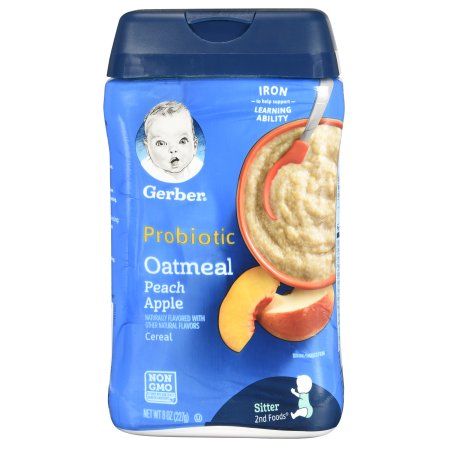 It takes a long time to cook it, then we use a mill and make oatmeal, it cooks faster, the porridge is more tender.
It takes a long time to cook it, then we use a mill and make oatmeal, it cooks faster, the porridge is more tender.
Oatmeal porridge can be introduced into the child's complementary foods after acquaintance with rice, buckwheat and corn porridge. The approximate age of the child is about 7-8 months. Although American pediatrics advises to introduce the baby to oatmeal from the age of 6 months, since it does not cause constipation. Many moms try introduce oatmeal much later closer to 10-12 months, because they are afraid of the reaction of a weak organism to gluten. But as I wrote above, oatmeal or oats do not contain gluten, if not contaminated.
The first oatmeal for children only dairy-free boiled in water with a small piece of butter. Oatmeal contains phytic acid, which prevents the absorption of calcium, so oatmeal is not recommended for children every day. To benefit from the product oatmeal porridge can be given 2-3 times a week. A serving of oatmeal until the year is approximately 200 grams, after - 200-300 grams. But you should not force the baby to eat up how much he ate, which means that the body needs so much.
A serving of oatmeal until the year is approximately 200 grams, after - 200-300 grams. But you should not force the baby to eat up how much he ate, which means that the body needs so much.
Introduction to complementary foods oatmeal occurs like any other new product with 1 tsp. in the morning, gradually increase the portion.
oats complementary foods
Oatmeal every day in complementary foods
The child loves oatmeal and eats only it every day. Mom is starting to panic! First you need to understand whether it is temporary? As I wrote in the article Era of Nutrition, this happens to children. Suddenly, the baby begins to love only one product and eat it for breakfast, lunch and dinner, this moment of nutrition is temporary from 2 to 8 weeks. He will pass. But encourage your child to eat oatmeal every day is not worth it, as I wrote above, it is not recommended to give oatmeal every day. Therefore, we try to give a variety of cereals for breakfast, alternating with eggs and dough dishes, for example, pancakes or pancakes.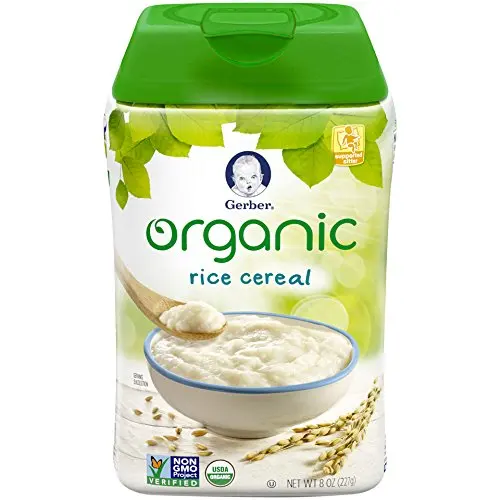 They can be made from rice or rye flour.
They can be made from rice or rye flour.
Life hack for moms
If oatmeal has become a favorite cereal, the child is ready to eat it at any time of the day, the mother is sure that this is not the era of nutrition, it is impossible to introduce other cereals, or everything moves so slowly that the mother is afraid, that oatmeal will do more harm than good. Then the store sells cereals of 3 cereals, 4 cereals, 5 cereals, 7 cereals of long cooking, there are even these cereals for sale by weight, usually sold on the market. Under the guise of oatmeal, the baby gets a variety.
I do not welcome this way of eating, especially if children are deceived, but when mother is in despair, mother is tired of fighting, mother does not know how to influence / persuade / beg / force a picky eater to eat something other than oatmeal, then this option as an outlet is very suitable. Moreover, the taste of these cereals is different, very suitable for a transitional moment, you can honestly admit to the baby that you will feed him oatmeal with additives, it tastes like oatmeal, but even tastier.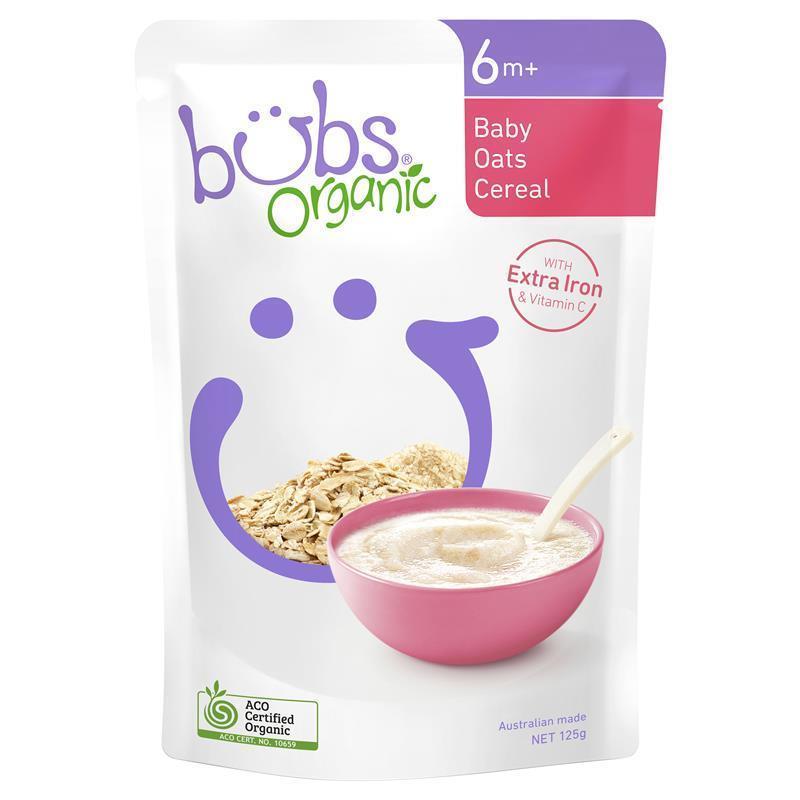 In short, we try, and suddenly it will be an ideal solution.
In short, we try, and suddenly it will be an ideal solution.
Allergy to oatmeal
Baby oatmeal is a good food for children because it has a low risk of allergic reaction. However, an allergic reaction is possible as a side effect, especially if it is contaminated with wheat gluten, as discussed above. Signs that a child has an allergic reaction to oatmeal include eczema, hives, diarrhea, vomiting, abdominal pain, lethargy, swelling of the face, and difficulty breathing. Allergy symptoms usually appear within two hours after eating. The extreme manifestation of food allergy is food protein-induced enterocolitis syndrome (FPIES), in which symptoms such as vomiting, abdominal pain, and diarrhea are severe. If you suspect that your child is showing signs of a food allergy, seek medical attention immediately.
How to choose and store oats for children?
Oat Selection: When choosing oats or standard oatmeal, you must select a product without added preservatives, sugar, salt or flavors.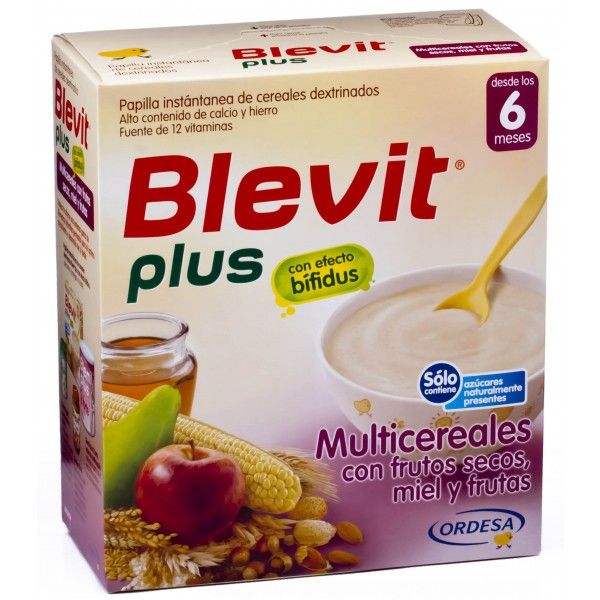 Oat flakes should be crumbly, without stale lumps and mold, as well as a characteristic musty smell. There should be a slight oatmeal smell. If we buy oats from a bag, then we choose sellers who quickly sell their goods.
Oat flakes should be crumbly, without stale lumps and mold, as well as a characteristic musty smell. There should be a slight oatmeal smell. If we buy oats from a bag, then we choose sellers who quickly sell their goods.
Storage Location: Whole grains and oatmeal can be stored for several months in a cool, dry place. Oatmeal should be stored in an airtight, airtight container and preferably in the refrigerator. Can be stored in a cool dry place, but it is important to check the condition of the flour if it is used infrequently.
When grains are ground, the natural oils derived from the grains can go rancid without refrigeration. When buying any type of ground whole grain, it is always better to buy less than throw away. We use the same storage methods for homemade oatmeal.
Like any other grain, oats can be susceptible to pest infestation. Keep the storage area clean while getting rid of pests such as moths. Avoid pills or poison from pests, as they can harm the child.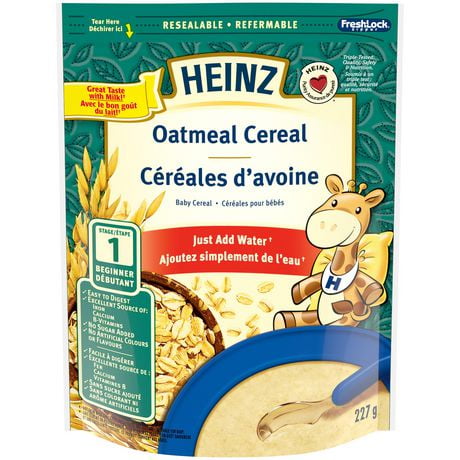 We buy small quantities that can be consumed within a short period of time. If we are going to store oats for a long period of time, we put them in an airtight container or a zipper bag and put them in the freezer. The low humidity and low temperature environment in the freezer helps maintain product quality.
We buy small quantities that can be consumed within a short period of time. If we are going to store oats for a long period of time, we put them in an airtight container or a zipper bag and put them in the freezer. The low humidity and low temperature environment in the freezer helps maintain product quality.
Freezing oatmeal
Leftover oatmeal can be frozen. It often happens, they cooked it, but a lot, either you finish eating after the child, or in the freeze, it's a pity to throw it away. Where can it be used? Of course, many would advise eating later, this is a good idea, thawed and eaten, but it is more interesting to use such porridge when making cutlets, pancakes or pies, cookies. Reduces cooking time and enriches the dish with useful minerals and vitamins. Milk oatmeal can also be frozen, but we defrost it in the refrigerator in the evening in order to add spices, such as cinnamon, to it in the morning. Still Frozen Oatmeal loses some flavor, but not much.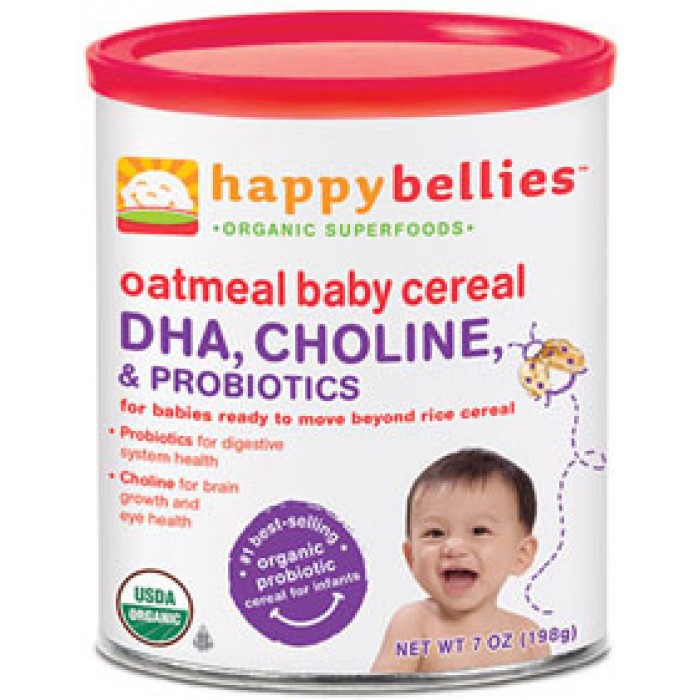
How to freeze oatmeal
Freezing is easy and simple, the main thing is to have ice or cake molds, you can also use ordinary large plastic freezer containers. It is convenient to decompose into small forms, freeze on a quick freeze, shock, and then decompose into special zip-packages for freezing with an indication of the date of freezing. Or put a bag in a large plastic container, put the porridge in it, when it freezes, take the bag out of the mold, put a large cube of porridge in the freezer. Defrost only in the refrigerator overnight, store in the freezer for about 6 months.
And another small comparison, it is better to eat thawed oatmeal, cooked from whole grains, than to brew instant oatmeal.
How to process oats for children?
We offer several ways to prepare oats, oatmeal, oatmeal or sliced oats:
Preparation of porridge from oatmeal for children over 7 months old:
Oatmeal is obtained from long-cooked oatmeal or from grain.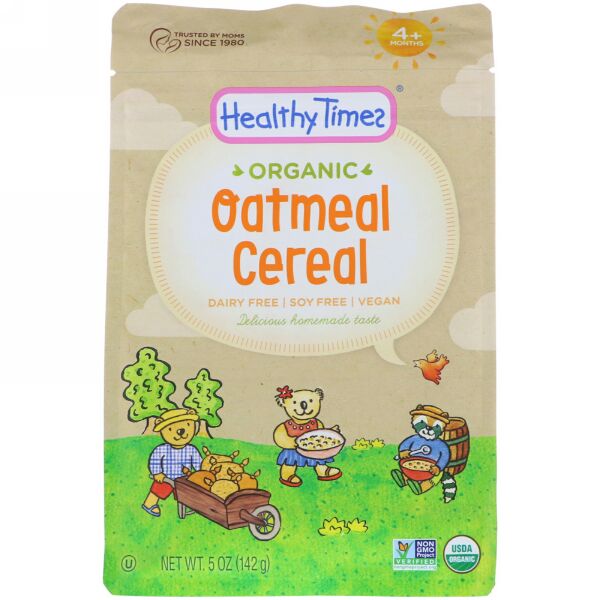
- Put the water on the fire, let it boil.
- For 100 ml of water we take 1-2 tablespoons of oatmeal.
- Stir thoroughly so that the porridge cooks evenly.
- Let cool after cooking. Mix with fruit and serve.
- You can add a little milk and butter at the end if it is included in the baby's complementary foods.
Cooking oatmeal / baby oatmeal for babies over 10 months:
- Soak oats in water for a few minutes.
- Put on fire and cook for about 10-15 minutes or according to the time recommended on the package.
- Add more water or milk to adjust the consistency.
- Milk should preferably be added at the end of the boil, 5 minutes before.
- Refrigerate. You can add fruit to oatmeal for a child.
Cooking porridge from whole and cut oats for children over 12 months old:
- Pour boiling water over groats for 6 hours, if with cold water, then for the whole night, then in the morning it will boil faster.
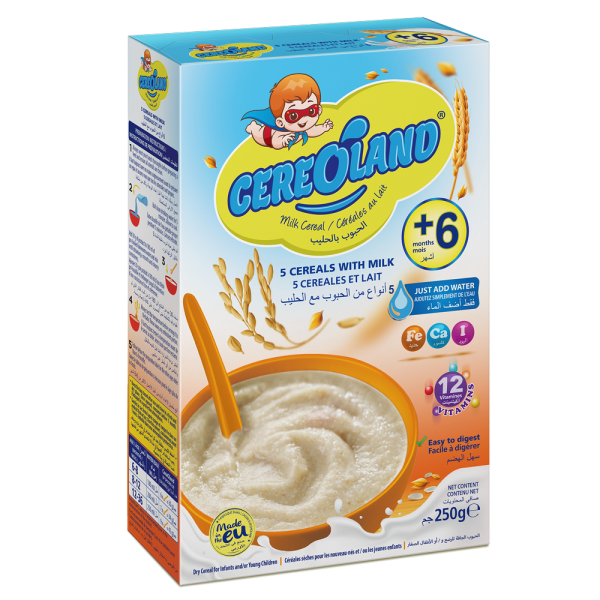
- The ratio of water and grain is 2 to 1, but here it depends on the density of the finished porridge, it will have to be determined empirically.
- Before cooking, drain the water and rinse the grain.
- When the water boils, reduce the fire.
- Porridge must be stirred slowly, the faster you stir, the more it thickens.
- Simmer the grain for about 30-40 minutes, and the cut grain is much smaller.
- Finally add milk and butter.
Please note that the age limits are approximate, it all depends on the age at which the baby got acquainted with oatmeal, at what age he began to eat finger food. Approximately, about 1-2 months are given for one consistency, i.e. we introduced oatmeal porridge, we cook it in this form for about a month, it is clear that the child is ready to switch to oatmeal, we are transferring, we are not ready to wait yet. You can cook many other healthy and tasty dishes for children from oats and oatmeal.
Storage of cooked oatmeal
Cooked oatmeal should be stored in the refrigerator for no more than 24 hours or frozen. It seems to me that oatmeal is delicious only freshly cooked, after standing for a while, it loses its amazing taste.
It seems to me that oatmeal is delicious only freshly cooked, after standing for a while, it loses its amazing taste.
Contraindications
Oatmeal should not be given to heart and kidney failure, individual intolerance and allergies, and celiac patients, if the oats are not cleaned and grown inappropriately, and also in case of an allergic reaction to avenin.
Oat milk
Oat milk is a popular dairy-free milk substitute.
It is made by soaking and mixing whole grains or oatmeal with water, then straining through cheesecloth to separate the milk from the oats.
Naturally, oat milk is not as nutritious as whole oats. As a result, industrial production often fortifies oat milk with nutrients including calcium, potassium, iron, and vitamins A and D.
Oat milk is unique in that it does not contain many of the allergens found in other milks. In addition, it contains beta-glucans, a soluble fiber that may benefit the heart.
Due to its growing popularity, oat milk can be found in most grocery stores or online. It can also be made at home.
How to make oat milk
It is very easy to prepare, but there are a lot of recipes. However, I tend to offer you 2 recipes for making oat milk.
Both recipes are prepared with long-cooked oatmeal.
First recipe: To make oat milk, simply take 1 cup long-cooked oatmeal and 4 cups of water, put in a blender, and blend for 30-45 seconds. Then strain through a clean cloth/gauze or sieve for best results.
This method produces a creamy oat milk that is ideal for adult coffee, adult and child smoothies, porridge, baked goods, muesli, and more.
The second recipe repeats the manipulations of the first except for one point. Let oatmeal stand in water for a day, but mucus is formed, which not everyone likes. You can try both methods of making oat milk and decide which is best.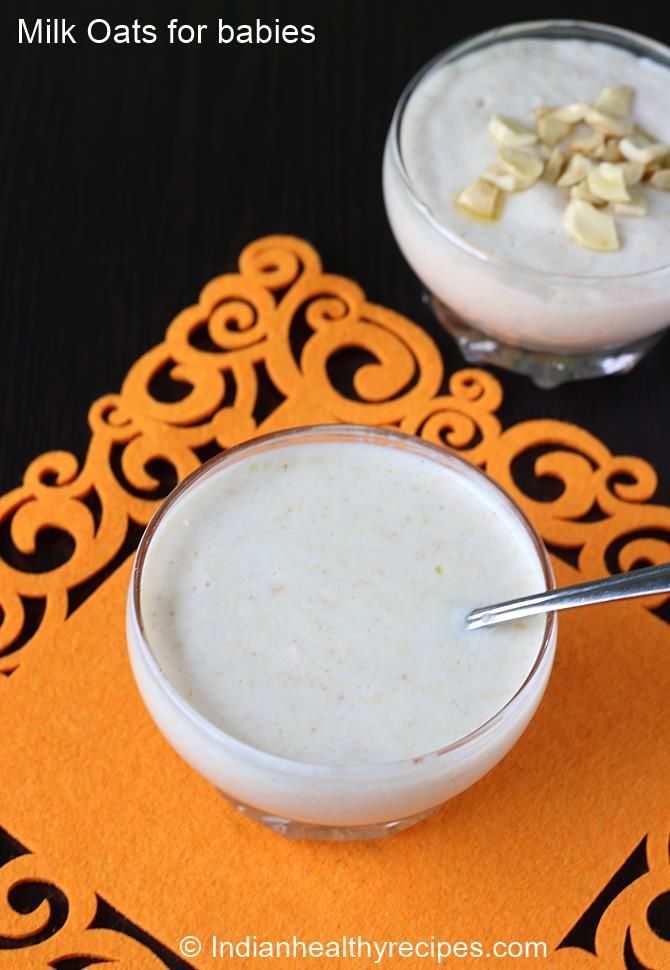
If you want to make oat milk from whole grains, then the oats are first ground in a coffee grinder to the state of flour. Used according to the recipes described above. Of course, whole grain oat milk is healthier, but more effort will be required.
Oat Baby Food
Oats pair best with:
- Milk is often the go-to choice for oats. You can make delicious porridge or smoothies.
- Almost all types of fruit have a pleasant taste with oats. Fruits like naturally sweet bananas go well with oats without even adding sugar.
- If you boil finely chopped vegetables with oats, you will get a delicious porridge for a child.
- Meat can be combined with oats in the same way as vegetables. You can make delicious meaty oatmeal using just oats, meat, and water, although onions and carrots can also be added.
Oats taste great with almost all foods, which means they can be part of a child's diet.
Oatmeal Mixing Ideas to Enrich the Taste of Baby Food
*All foods must be introduced into the baby's diet. Oat finger food is a product made from oat flour or oat flakes. You can buy them or make your own at home. The simplest example of oat finger food is baby biscuits, they are soft, crumble easily, made from a mixture of various flours, including oatmeal. And so parents can cook pancakes, pancakes, cookies, etc. and offer the child the product as a finger food. Prepackaged Baby Food offers many oatmeal products. The list below is only a small part of the products of the modern food market. Basically, the production of baby food offers dry and ready-made oatmeal cereals, drinks, cookies, oatmeal is also often added to baby puree, sometimes just for taste and nutritional variety, and sometimes as a thickener. NEMOLOKO Nestle Malyutka Fleur Alpine heinz Frutonyanya Bibikol Here are some more tips to help you get the most out of your oats!
 You can even freeze cooked oatmeal.
You can even freeze cooked oatmeal. Oat finger food
Oatmeal Prepackaged Baby Food
 Therefore, if the child is not yet familiar with oats, then carefully read the composition of children's jars.
Therefore, if the child is not yet familiar with oats, then carefully read the composition of children's jars.
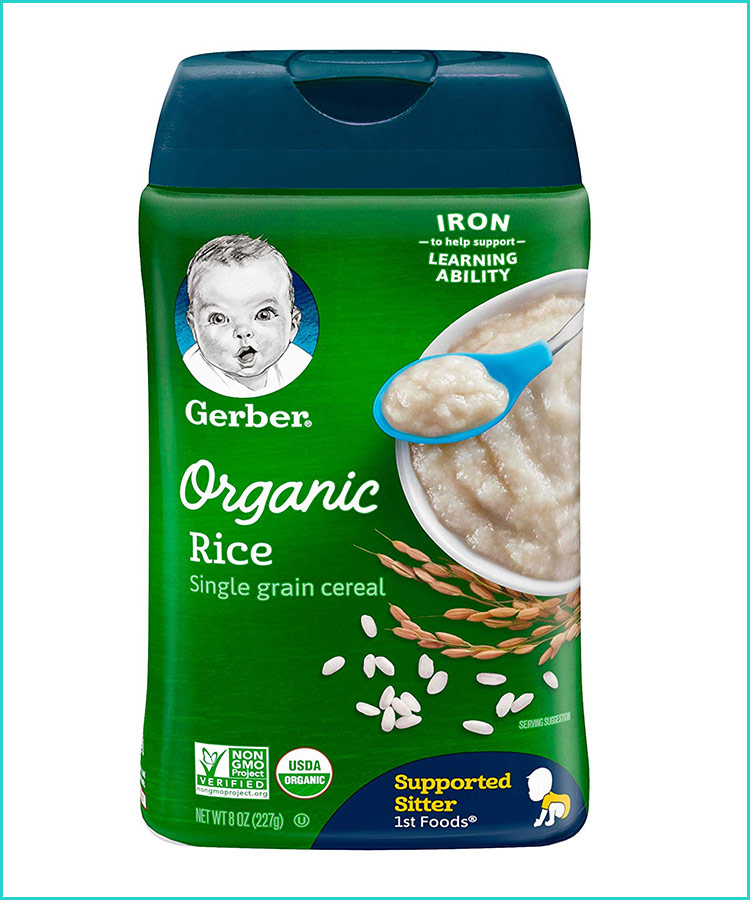 5 liters
5 liters
Clever
Mamako
- Possess Moloen with goat's milk from 6 months 200 grams
- Milk oatmeal with prunes with goat's milk from 6 months 200 grams
- 5-grain porridge with goat's milk from 6 months 200 gram
- 7-grain porridge with berries with goat's milk from 6 months 200 gram
BEBI
- Silent oatmeal with 5 months 200 grams
- Silent oatmeal porridge with 6 months 200 grams
- Persian puppet with 5 months 250 grams
- Moloral oatmeal from 5 months 250 grams
- Milk porridge 3 cereals with raspberries and lemon balm with prebiotics Premium, from 6 months, 200 grams
Baby Sitter
- Dairy-free Oatmeal porridge from 5 months 200 grams
- Silent -free millet cereals with cereals from 6 months 200 grams
- Silent cereal with 6 months 200 grams
- Silent oatmeal with a banana and lemon balm from 6 months 20028
- Castle melting mulm 6 months 200 grams
- Oat-wheat milk porridge with apple from 6 months 250 grams
- Oat-wheat milk porridge fruit-yogurt from 8 months 50 grams
- Oat-wheat apple milk porridge Good night from 6 months 250 grams
- Oatmeal puree with apricots and apples from 6 months, 190 grams months 200 grams
- Mini instant biscuits 5 cereals, from 6 months 40 grams
Bellakt
- Dairy-free oatmeal porridge with forest berries, from 6 months 200 grams
- milk oatmeal 5 grams 5 months0028
- Military corn and pear from pear from 5 months 250 grams
- Silent porridge 7 cereals with 6 months 20028
- Dairy oatmeal with apple and high-rise from 5 months 220 grams
- Milk porridge 3 cereals with mango and banana from 6 months 200 grams
- Milk porridge 5 cereals with prebiotics from 6 months 200 grams
- Milk porridge 3 cereals with fruit from 6 months 200 grams
- Dairy porridge 5 apple-malpan-rally from 6 months 200 grams
- Milk oatmeal with 5 months 20028
- Milk Veling oatmeal with a banana and prunes from 8 months 435 grams 9002 multi-cereal from 11 months 435 grams
- Porridge-multifruit pouch puree from 6 months 120 grams
- Porridge-apple-peach pouch puree from 6 months 120 gram
- Porridge-pear-apricot puree pouch from 6 months 120 grams
- Fruit-grain porridge-pear-prune pouch fruit-grain puree from 6 months 120 grams
Nutrilon
- Silent oatmeal from 6 months 180 grams
- Silent multiple multislay from 6 months 180 grams
- Milk Ovsyanny with raspberry0028
- Milk oatmeal porridge from 5 months 200 grams
- Milk cereal porridge pear banana 2.
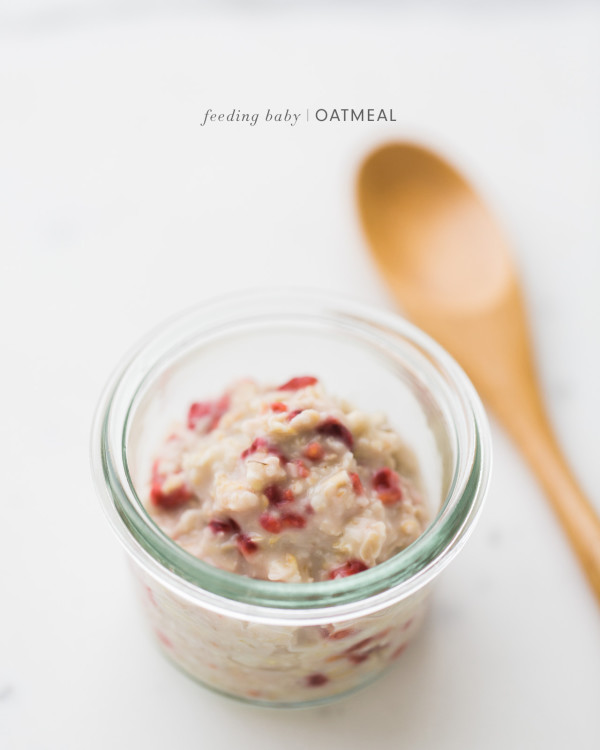 7% from 6 months 200 grams months 90 grams
7% from 6 months 200 grams months 90 grams - ADV BANAN-Banan-Bannik-Slaki Pauchek from 6 months 130 grams
Kabrita
- Porridge 7 cereals on a goat with 6 months 180 grams
- mashed potatoes from 6 months 100 grams
- puree beef-bevel from 6 months 100 grams
with a mustache
- Porridge 5 months 0.2 liter
- Porridge porridge pp. 6 months 0.2 liters
Gerber
- Puree pear-raspberry-cereals from 6 months 90 grams, pouch
- Puree Fruit Cocktail from 6 months 90 grams, pouch-grains months
- 0 gram, pouch
- Apple-cereal-yogurt puree from 8 months 90 grams, pouch
- Banana-blueberry-cereal-yogurt puree from 8 months 90 grams, pouch
Marmaluzi
yogurt 8 months 190 grams Peek-a-Boo- Puree apple-Banan-Banno-Klubnik-Kusyanka from 6 months 113 grams
grass and spices that perfectly complement the taste of oats:
- Koritsa,
- Cardamom,
- Cloves,
- Muscator,
- Ginger,
- honey,
- Vanil,
- Parsley,
- Dill,
- CNOMS seeds
- Carry, etc.
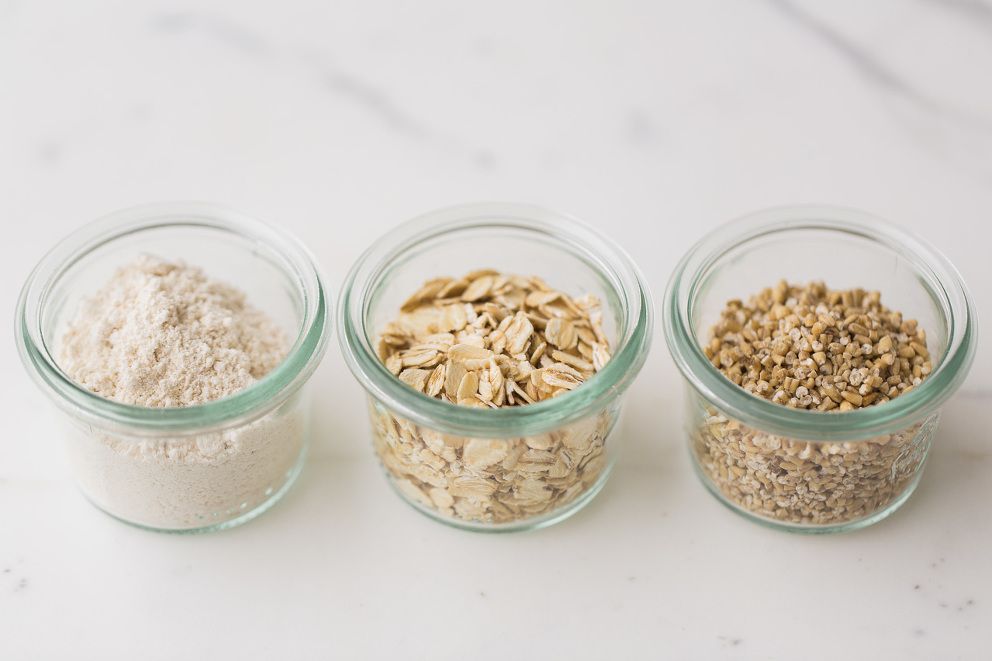
how many months to introduce oatmeal to a child
Published: 09.12.2019
Reading time: 4 min.
Number of reads: 46044
Oatmeal is the most popular breakfast among residents of many countries. The excellent taste of this dish and the energy boost of slow-digesting carbohydrates make for a good start to the day for all family members. The word "oats" comes from the Latin avere, which means "to be healthy". Oatmeal is also known under the name "oatmeal" - after the name of the ancient Greek mythological hero, endowed with great physical strength and endurance. Oatmeal is included in the mandatory diet of not only Olympic champions, this product appears one of the first on the baby's menu in the first year of life. Let's look at why oatmeal occupies an honorable place in the pyramid of healthy eating and when to introduce this healthy product into the child's diet.
Content: Hide
- Oat carbohydrates
- Oat proteins and fats
- Oat active ingredients
- Timing of the introduction of cereal complementary foods
- Oatmeal Safety
- Choice of porridge
- Bebi Premium Oatmeal
Oat carbohydrates
All cereals are a source of carbohydrates, primarily starch, which determines a surge of energy and a long-lasting feeling of fullness after eating porridge.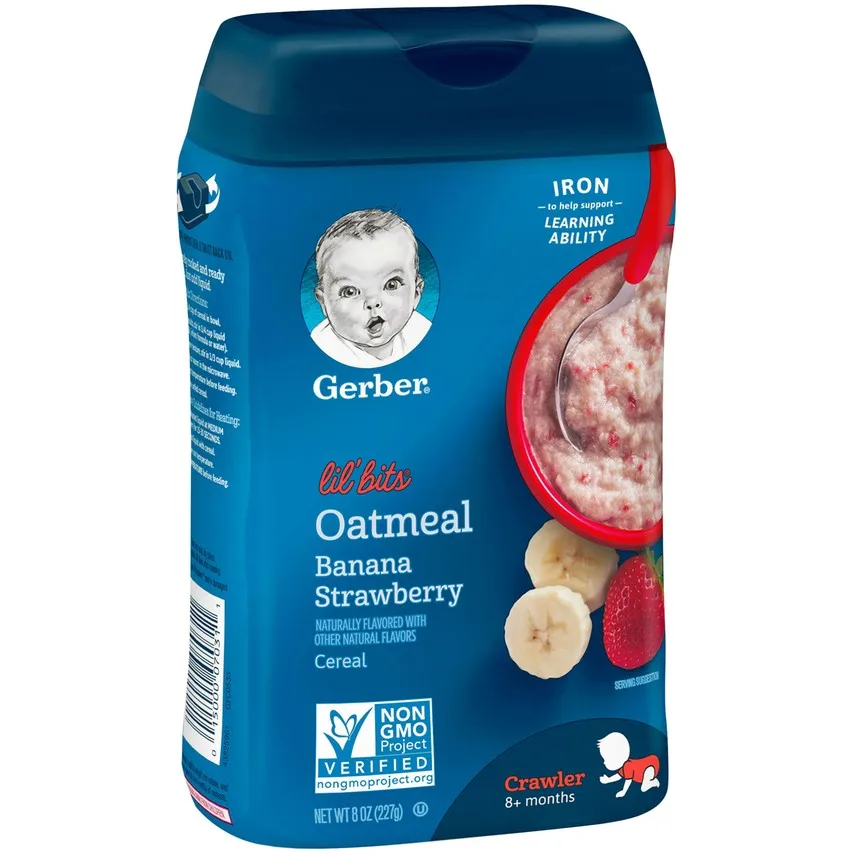 This is due to the slow digestion and gradual assimilation of the product. Oatmeal is rich in starch, but compared to other cereals, its proportion is less. However, starch grains are very small, which determines its almost complete assimilation. The rest of the slowly digestible carbohydrates are dietary fiber, and oatmeal surpasses many cereals in the content of this component. Vegetable fiber is very important for the normal process of digestion and also serves as a natural food for the gut microbiome. Maintaining the numerical composition and diversity of one's own intestinal microflora is an indisputable factor in human health. Oatmeal contains unique soluble dietary fiber, which has an enveloping effect, protecting the mucous membrane of the stomach and intestines. In addition, oat fiber helps to eliminate toxins and has a positive effect on cholesterol levels. Products based on oatmeal are used not only in the diet of a healthy person, but also in therapeutic nutrition schemes.
This is due to the slow digestion and gradual assimilation of the product. Oatmeal is rich in starch, but compared to other cereals, its proportion is less. However, starch grains are very small, which determines its almost complete assimilation. The rest of the slowly digestible carbohydrates are dietary fiber, and oatmeal surpasses many cereals in the content of this component. Vegetable fiber is very important for the normal process of digestion and also serves as a natural food for the gut microbiome. Maintaining the numerical composition and diversity of one's own intestinal microflora is an indisputable factor in human health. Oatmeal contains unique soluble dietary fiber, which has an enveloping effect, protecting the mucous membrane of the stomach and intestines. In addition, oat fiber helps to eliminate toxins and has a positive effect on cholesterol levels. Products based on oatmeal are used not only in the diet of a healthy person, but also in therapeutic nutrition schemes.
Proteins and fats of oats
Oat groats in terms of vegetable protein content can only compete with buckwheat and are significantly superior to other cultivated cereals in this characteristic. In addition to the quantitative content, the qualitative composition of the protein is very important: oatmeal contains almost all essential amino acids in a balanced ratio. These substances are not synthesized in the human body, but are absolutely necessary for life, especially during periods of intensive growth. Among them, the content of lysine, methionine and tryptophan is especially important. These amino acids are very important for the development of the immune and nervous systems. Oat protein is easily digestible, therefore products based on this cereal are widely recommended in dietary and baby food. Oatmeal contains a fairly large amount of vegetable fats, which also determines the high nutritional value of the product. They are easy to digest, almost completely absorbed and stable to oxidation. The qualitative composition of oat oils is also important, which is characterized by the content of essential fatty acids (oleic, linoleic and linolenic) in the most favorable ratio.
In addition to the quantitative content, the qualitative composition of the protein is very important: oatmeal contains almost all essential amino acids in a balanced ratio. These substances are not synthesized in the human body, but are absolutely necessary for life, especially during periods of intensive growth. Among them, the content of lysine, methionine and tryptophan is especially important. These amino acids are very important for the development of the immune and nervous systems. Oat protein is easily digestible, therefore products based on this cereal are widely recommended in dietary and baby food. Oatmeal contains a fairly large amount of vegetable fats, which also determines the high nutritional value of the product. They are easy to digest, almost completely absorbed and stable to oxidation. The qualitative composition of oat oils is also important, which is characterized by the content of essential fatty acids (oleic, linoleic and linolenic) in the most favorable ratio.
Biologically active substances of oats
Useful properties of oat groats are connected not only with the content of essential nutrients.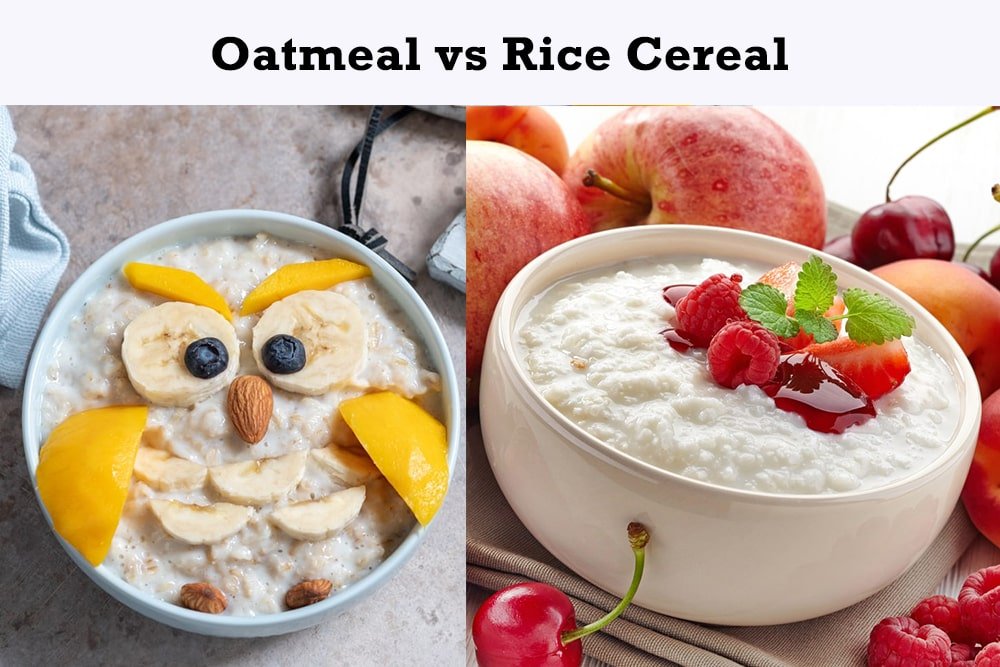 The restorative effect and a positive effect on the work of almost all organs and systems of the body are also determined by the micronutrients included in the composition. The high content of B vitamins (especially B 1 and biotin) has a beneficial effect on metabolism and ensures high performance. In combination with a sufficient intake of magnesium, and oats are also rich in this mineral, a person’s mental activity improves, sleep and mood normalize. Oatmeal is rich in vitamin E, which is necessary for the functioning of the immune and reproductive systems, has a positive effect on the condition of the skin and hair. The high content of silicon and phosphorus has a beneficial effect on physical development, musculoskeletal system and linear growth. In terms of the content of trace elements such as copper and manganese, oats absolutely surpass other cereals. Copper is part of numerous enzymes that provide cellular respiration, as well as liver cells that neutralize toxins.
The restorative effect and a positive effect on the work of almost all organs and systems of the body are also determined by the micronutrients included in the composition. The high content of B vitamins (especially B 1 and biotin) has a beneficial effect on metabolism and ensures high performance. In combination with a sufficient intake of magnesium, and oats are also rich in this mineral, a person’s mental activity improves, sleep and mood normalize. Oatmeal is rich in vitamin E, which is necessary for the functioning of the immune and reproductive systems, has a positive effect on the condition of the skin and hair. The high content of silicon and phosphorus has a beneficial effect on physical development, musculoskeletal system and linear growth. In terms of the content of trace elements such as copper and manganese, oats absolutely surpass other cereals. Copper is part of numerous enzymes that provide cellular respiration, as well as liver cells that neutralize toxins.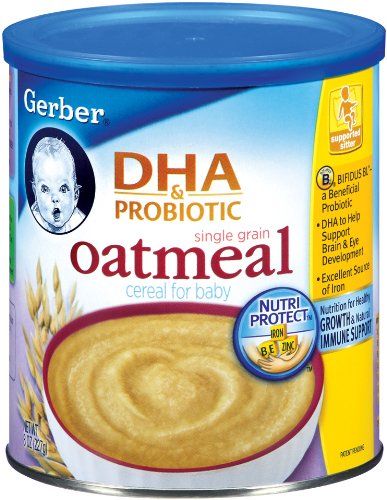 Manganese is very important for hematopoiesis and energy metabolism. Oat grains are a natural source of flavonoids that protect cells from destruction and premature aging.
Manganese is very important for hematopoiesis and energy metabolism. Oat grains are a natural source of flavonoids that protect cells from destruction and premature aging.
Timing of the introduction of cereal complementary foods
At what age can this healthy and nutritious product be introduced into the baby's diet? For the first four months of life, the baby's body can only absorb mother's milk or an adapted mixture, since the gastrointestinal tract and kidneys are still functionally immature. The process of maturation is individual, but for most infants, by the 4-6th month of life, it is already possible to introduce complementary foods. Moreover, by this age, the nutritional value of breast milk or formula is no longer enough to ensure intensive growth and development of the baby. There is a need to expand the diet. Cereal products are the most preferred choice of first complementary foods. They are distinguished by high nutritional and energy value, the content of almost all essential nutrients, as well as good compatibility with breast milk.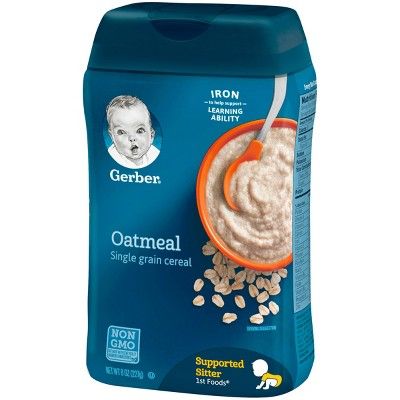 As the first complementary food product, a baby can be offered dairy-free porridge or cooked on the basis of mother's milk. The familiar taste will allow the child to quickly adapt to changes in nutrition, which will facilitate the introduction of complementary foods in the future.
As the first complementary food product, a baby can be offered dairy-free porridge or cooked on the basis of mother's milk. The familiar taste will allow the child to quickly adapt to changes in nutrition, which will facilitate the introduction of complementary foods in the future.
Safety of oatmeal
At what age can you start complementary foods with oatmeal? The introduction of cereals in the first 6 months of life has limitations associated with the possible toxic effect on intestinal cells of vegetable gluten protein. Early mucosal contact with this protein can cause serious disease. Therefore, the list of cereals that can be used for the first feeding includes rice, corn and buckwheat. The question of the toxicity of oats for the immature mucosa of the baby still remains completely unresolved. According to most experts, oatmeal is a safe protein, but oatmeal can be contaminated with impurities from other cereals. Therefore, this product is introduced into the child's diet after 5 months of life.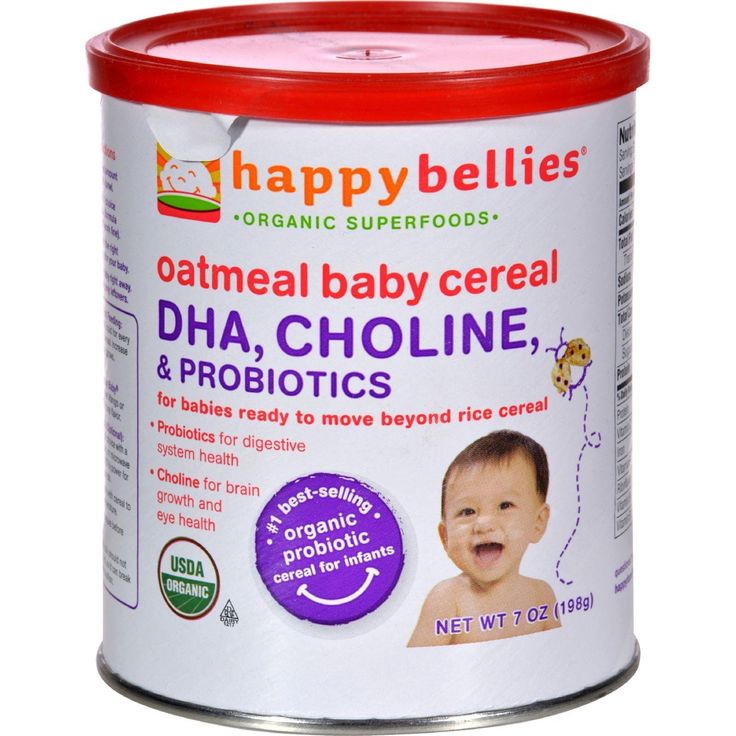
Choice of porridge
How to prepare oatmeal for baby food? This is a simple but at the same time very important practical question. Despite the apparent simplicity of home-made cereals, specialized baby food products are the preferred choice. The modern level of industrial production determines the high quality standard of finished products so that every child can get the best for healthy growth and development. Bebi Premium baby food cereals are a well-thought-out recipe that meets the needs of a child in every age period, and guaranteed quality of raw materials, at all stages of production in accordance with international safety standards.
Bebi Premium oatmeal
All Bebi Premium oatmeal porridges are made on the basis of cereals, not flakes, which allows you to preserve the beneficial properties of the grain shell as much as possible. In their production, a special technology of grain processing and subsequent drying is used, which makes it possible to produce cereals based on cereals, but no heat treatment is required during cooking.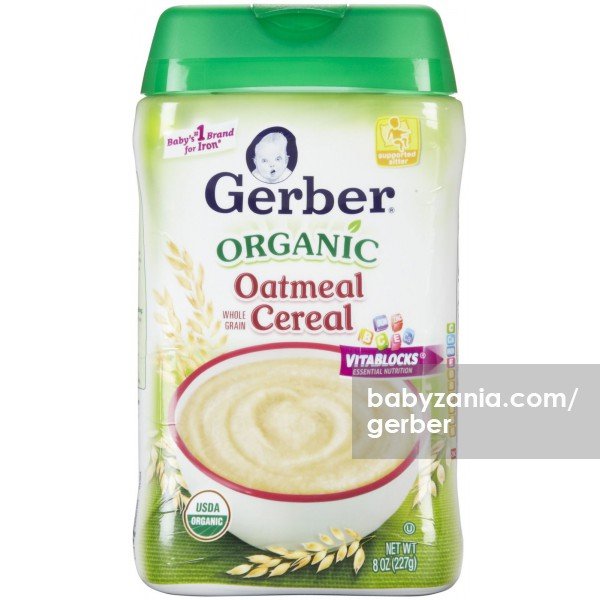 At the same time, a delicate taste and the necessary degree of grinding of the finished product are preserved. A great choice to start your oatmeal introduction to babies over 5 months old is Bebi Premium Oatmeal Without Dairy. In addition to the beneficial properties of oatmeal, the composition of the product is enriched with the natural prebiotic inulin, as well as a unique vitamin and mineral complex. Then the baby can be offered another tasty and nutritious product of the Bebi Premium line - “Oatmeal porridge with milk”. All Bebi Premium milk porridges contain special baby milk, which is allowed from 4 months of age. To further enrich the diet with pectins, sugars and organic acids, the menu can be expanded with cereals with fruit and vegetable components. "Oatmeal porridge with peach and milk" Bebi Premium contains 100% natural peach puree, which gives the product natural sweetness, expands the range of taste sensations and gradually prepares the baby for the introduction of fruit and berry complementary foods.
At the same time, a delicate taste and the necessary degree of grinding of the finished product are preserved. A great choice to start your oatmeal introduction to babies over 5 months old is Bebi Premium Oatmeal Without Dairy. In addition to the beneficial properties of oatmeal, the composition of the product is enriched with the natural prebiotic inulin, as well as a unique vitamin and mineral complex. Then the baby can be offered another tasty and nutritious product of the Bebi Premium line - “Oatmeal porridge with milk”. All Bebi Premium milk porridges contain special baby milk, which is allowed from 4 months of age. To further enrich the diet with pectins, sugars and organic acids, the menu can be expanded with cereals with fruit and vegetable components. "Oatmeal porridge with peach and milk" Bebi Premium contains 100% natural peach puree, which gives the product natural sweetness, expands the range of taste sensations and gradually prepares the baby for the introduction of fruit and berry complementary foods.